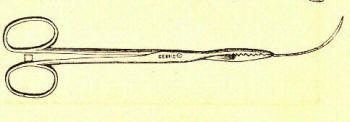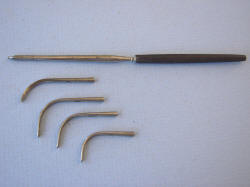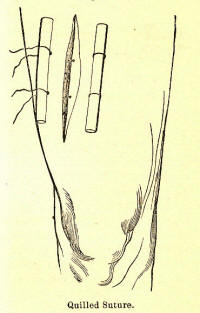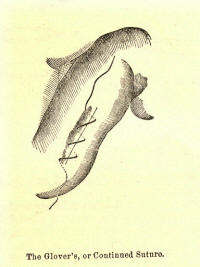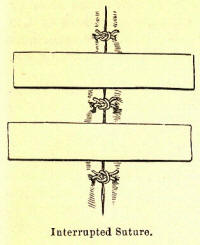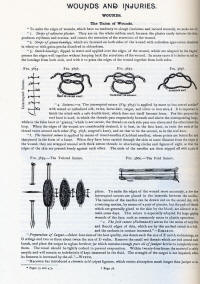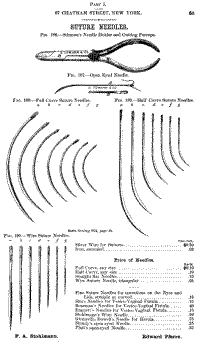Suture Needles and Suturing During the Civil War Era
Last updated: Monday, December 09, 2024
Sometimes the most obvious things are sitting right under your nose. Based on how suturing is done today, it suddenly dawned on me I had never seen a suture forceps in any of the surgical sets of my pre-1870 collection. None! There were lots of suture needles and suture materials (wire and thread), but no suture needle forceps! Why? ...Because they used their fingers to suture, just like women and tailors of the time used their fingers to sew! That is why the curved and straight needles found in surgical sets are so large. The suture needles of today are very fine and curved along the size of a dime and require handling by sturdy needle forceps to place sutures, where as those prior to the late 1880's were curved along the size of a silver dollar or twenty dollar gold piece and sutures were placed by hand in most cases. Now, all that being said, there were 'needle holders', just not the type we associate with suturing later in the 1900's. Forceps with grooves in the beaks are seen that would have stabilized a suture needle. But dedicated locking suture needle holders per se, were not commonly found in American sets.
In one Snowden and Brother Civil War surgical case, I found a Physick's forceps which is expressly used to hold a needle firmly in a grove in the jaws of the tip. I have also seen this Physick's forceps referred to in multiple texts for deep suturing in a wound.
Physick's forceps for suturing
As shown below, there were needle holders available in an 1846 text book by Liston and Mutter, but I have not seen one in any pre-1870 American set I've examined. That is not to say they didn't exist, because they did, but just not in the hundreds of earlier amputation sets or Civil War surgical sets I have examined over fifteen years.
Size references: $1 silver, $20 gold, $10 gold
Click on any image to enlarge
Pins used to approximate the sides of a soft tissue incision, from an 1864 Tiemann surgery set. The pins are round with a round, not a flat head. These needles were found in the paper holder and would have been supplied this way. In the diagram, the pins are shown with suture material wrapped in a criss-cross on either side of the incision and tied to close the incision, rather than being passed through the tissue.
An image of a Buck's suture pin director is shown, which would have been used to guide the placement of a pin.
Various curved and straight cutting edge suture needles. If you enlarge the photos, you can see that the needles are flat, not round and the edges are very sharp (cutting edge suture needles). In a typical amputation set, the various needles are stored in a piece of buckskin leather.
In this set of photos are the various needles, suture thread or silk (still in the original wrapping paper), 2 loops or spools of silver suture wire and pieces of bone wax (used to stop bleeding of cut bone). From Civil War Hosp. Dept. surgical sets.
In this drawing of a cutting suture needle, you can see the back end of the needle has a cut-out which allows either thread or silver wire to pass out the back end of the needle for smooth passage through tissue. The image is illustrating Price's needle for wire suture. On the left is an example of the same curved needle as above with suture thread showing the thickness of the thread and groove in the back end of the needle. Also shown on the right are two coils of silver suture wire and dark suture material.
_small.JPG)
In the image to the right is shown an aneurism needle, which was not used to suture an incision, but to ligate an artery or vein. They can be found in many amputation or surgery sets. In Liston and Mutter's text, 1848, Liston (an English surgeon) shows a locking handle suture needle holder, but I have never seen one in an American-made set with the exact design of the handle. I have see the smaller Snowden Physick's forcep in a leather pocket kit like the one shown below the longer locking type. Tiemann developed a locking suture needle holder, called a Degaine's Russian Needle Holder after the Civil War 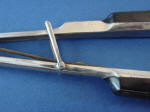
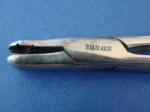
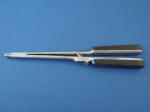
A drawing from the 1866 Gemrig catalogue showing a 'locking' forceps for carrying a suture needle. See the 1866 Gemrig catalogue. The importance of this drawing is it shows use of a locking catch between the finger holes of the forceps, which allows locking the needle in place during use. See an article on this instrument which dates this style to 1864 by French maker Mathieu Aneurism needles with detachable handle above, used to ligate or tie-off arteries, not to 'suture' a wound or incision
Shown in this image is a method of using 'quills' on either side of an incision, which would have been approximated by passing an intra-dermal suture from side to side and then tightening the suture when tying to draw the two sides together. ( From Gross's Surgery text, 1856 ). An example of what would be called a 'continuous' suture where the suture needle is passed in a circular spiral down the length of an incision and tied on each end. (From, Gross, Surgery text, 1856) An example of an interrupted suture, with individual sutures which were each tied and cut . The image shows tape between each suture. From the 1886 Tiemann catalogue, a discussion of suturing and sutures
Surgical suture needles from the 1870's Tiemann catalogue, 67 Chatham St. These are some type of double ended threading needles or awls, with no eye. One is marked "NEA & NCO", but they are heavy duty and not typical. About 3 in. long. Triangular on one end, round on the other. From a U.S. Navy, Wade and Ford surgery set, c. 1865.
From the medical text book Handbook of Surgical Operations, 1863, (in this collection) written during the Civil War by Stephen Smith, M.D.:
Sutures.—In the application of the suture the needle and thread are employed. The best form of needle for general ' use is about two inches in length, and straight two-thirds of its length, the remaining third being gently curved, with two cutting edges (Fig. 9). In some cases a needle curved throughout its entire length is found useful, as where the wound is deeply seated; finally, the straight needle, with sharp point and three cutting edges, is the most serviceable form in wounds on a slightly elevated surface. In some deeply- seated wounds, a needle with a handle that is fixed or attached by a screw, will answer a better purpose than either of those described.
Material for Sutures.—The material used for sutures may be animal, vegetable, or metallic.
Of the first, catgut has been most frequently employed; it has, however, never proved reliable.
Of the second, silk is almost universally selected, and still maintains its supremacy as a suture and a ligature. What is known as dentists' silk, with three threads, is the best form.
Of the third, the silver wire is preferred, as combining the least irritating properties with great flexibility. It may be obtained of different sizes, and the larger should generally be preferred, as it is less liable to cut the edges of the wound. The wire suture may be inserted with the common surgical needle, but a needle has been devised by Mr. Lister, having a groove in the shaft from the eye to the butt, in which the wire is completely buried, and which thus prevents the mass of wire occasioned by its being doubled upon itself at the eye. Another needle answering the same purpose has been invented by Mr. Price , which has two eyes, and a groove on each surface; the wire is passed from the lower to the upper, and then doubled and twisted.
There are various forms of suture, as follows:
Interrupted Suture.—A needle of the desired shape, armed with a ligature of the material chosen, is passed from without inwards through the right lip of the wound, at a distance from its margin, varying from a line to one-third of an inch, and being continued, it should be passed through the left lip from within outwards, exactly opposite the point of insertion in the right. All the sutures should be introduced before any are tied; the common reef-knot is then made, and the ends cut off closely.
Continued Suture.—This suture is that made by the glover, and consists in passing the needle, as in the interrupted suture, diagonally, and leaving the thread uninterrupted ; it is used in wounds of the intestines.
Quilled Suture.—In this suture the double thread is passed through the lips of the wound, as in the interrupted suture, but at greater distances, and the ends are tied over quills or pieces of bougie cut of the proper length. It is used to close deep wounds.
Twisted Suture.—This suture is made by introducing a needle of steel, silver, or other unirritating metal through the sides of the wound, as in the uninterrupted suture, and then twisting the thread around the ends in the form of a figure-of-eight, or directly forming an ellipse. When several needles are required they should all be introduced before the thread is applied, which should then also take a diagonal direction between the pins to protect the intervening spaces. This suture is employed after operations for hare-lip.
Article on anesthesia during the Civil War
Article on ligation of an artery during the Civil War
Article on chloroform during the Civil War
Article on how an amputation was done during the Civil War
Additional information on the Chisolm ether and chloroform inhaler
_small.JPG)

_small.JPG)
_small.JPG)

_small.JPG)
_small.JPG)
_small.JPG)
_small.JPG)



